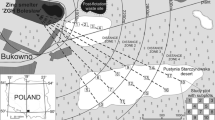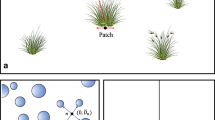Abstract
Recent data on oribatid mites (Acari: Oribatida) indicates that Mediterranean soil communities tend to show uneven patterns of species abundance distribution (SAD) that are well fitted by a simple model such as the geometric series. In the case of linear distributions, the fraction of total sampled individuals that is contributed by the most abundant species, known as the Berger–Parker index, synthetically describes the SAD of disturbed communities. This study assessed the bioindicator potential of the Berger–Parker index by comparing its variations among Mediterranean oribatid assemblages under different types of soil disturbance. The index significantly changes between undisturbed and disturbed soils reaching the highest values in areas with strong physical disturbance due to agricultural management. The Berger–Parker index is therefore a practical and effective tool for monitoring biodiversity impairment linked to human disturbance in soil ecosystems.

Similar content being viewed by others
References
Anderson MJ (2005) PERMANOVA: a FORTRAN computer program for permutational multivariate analysis of variance using permutation tests. Department of Statistics, University of Auckland, Auckland, New Zealand
Behan-Pelletier VM (1999) Oribatid mite biodiversity in agroecosystems: role for bioindication. Agric Ecosyst Envir 74:411–423
Berger WH, Parker FL (1970) Diversity of planktonic foraminifera in deep-sea sediments. Science 168:1345–134
Caruso T, Noto La Diega R, Bernini F (2005) The effects of spatial scale on the assessment of soil fauna diversity: data from the oribatid mite community of the Pelagian Islands (Sicilian Channel, southern Mediterranean). Acta Oecol 28:23–31
Caruso T, Migliorini M (2006a) Micro-arthropod communities under human disturbance: is taxonomic aggregation a valuable tool for detecting multivariate change? Evidence from Mediterranean soil oribatid coenoses. Acta Oecol 30:46–53
Caruso T, Migliorini M (2006b) A new formulation of the geometric series with applications to oribatid (Acari, Oribatida) species assemblages from human-disturbed mediterranean areas. Ecol Mod 95:402–406
Chase JM (2005) Towards a really unified theory for metacommunities. Funct Ecol 19:182–186
Chung AYC, Eggleton P, Speight MR, Hammond PM, Chey VK (2000) The diversity of beetle assemblages in different habitat types Sabah, Malaysia. Bull Entomol Res 90(6):475–496
Clarke KR, Warwick RM (1994) Change in marine community: an approach to statistical analysis and interpretation. Plymouth Marine Laboratory, Natural Environment Council, Plymouth, U.K.
Fountain MT, Hopkin SP (2001) Biodiversity of Collembola in urban soils and the use of Folsomia candida to assess soil “quality”. Ecotoxicology 13:555–572
Franchini P, Rockett CL (1996) Oribatid mites as “indicator” species for estimating the environmental impact of conventional tillage practices. Pedobiologia 40:27–225
Fulé PZ, Laughlin DC, Covington WW (2005) Pine-oak forest dynamics five years after ecological restoration treatments, Arizona, USA. Forest Ecol Manag 218:129–145
Hågvar S (1994) Log-normal distribution of dominance as an indicator of stressed soil micro-arthropods communities). Acta Zool Fennica 195:71–80
Hilszczañski J, Gibb H, Hjältén J, Atlegrim O, Johansson T, Pettersson RB, Ball JP Danell K (2005) Parasitoids (Hymenoptera, Ichneumonoidea) of Saproxylic beetles are affected by forest successional stage and dead wood characteristics in boreal spruce forest. Biol Conserv 126(4):456–464
Hubbell SP (2001) The unified Neutral Theory of Biodiversity and Biogeography. Monographs in population biology, Princeton University Press, Princeton, USA
Hubbell SP (2005) Neutral Theory in community ecology and the hypothesis of functional equivalence. Funct Ecol 19:166–172
Lindo Z, Visser S (2004) Forest floor microarthropod abundance and oribatid mite (Acari: Oribatida) composition following partial and clear-cut harvesting in the mixed-wood boreal forest. Can J Forest Res 34:998–1006
Magurran AE (1988) Ecological diversity and its measurement. Croom Helm, London
Maraun M, Salamon J-A, Schneider K, Schaefer M, Scheu S (2003) Oribatid mite and collembola diversity, density and community structure in a moder beech forest (Fagus sylvatica):effects of mechanical perturbations. Soil Biol Biochem 35:1387–1394
May RM (1975) Patterns of species abundances and diversity. In: Cody ML, Diamond JM (eds), Ecology and Evolution of Communities. Belknap Press of Harvard University Press, Cambridge, MA, pp 81–120
McArdle BH, Anderson MJ (2001) Fitting multivariate models to community data, a comment on a distance-based redundancy analysis. Ecology 82:290–297
McCune B, Mefford MJ (1999) PC-ORD. Multivariate analysis of Ecological Data, Version 4. MjM Software Design, Gleneden, Beach, OR, USA.
McGill BJ, Enquist BJ, Weiher E, Westoby M (2006) Rebuilding community ecology from functional traits. Trends Ecol Evol 21:178–185
Migliorini M, Petrioli A, Bernini F (2002) Comparative analysis of two edaphic zoocoenoses (oribatid mites and Carabid beetles) in five habitats of the Pietroporciana and Lucciolabella nature reserves (Orcia Valley, central Italy). Acta Oecol 23:361–374
Migliorini M, Fanciulli PP, Bernini F (2003) Comparative analysis of two edaphic zoocoenoses (Acari Oribatida; Hexapoda Collembola) in the area of Orio al Serio Airport (Bergamo, northern Italy). Pedobiologia 47:9–18
Migliorini M, Pigino G, Avanzati A, Salomone N, Bernini F (2004). Experimental fires in Mediterranean environment: effects on oribatid mite communities. In: Weigmann G, Alberti G, Wohltmann A (eds) Phytophaga: Acarine biodiversity in the natural and human sphere. Proceedings of the V Symposium of the European Associations of Acarologists. Luxograph, Palermo, Italy, pp 271–278
Migliorini M, Pigino G, Caruso T, Fanciulli P, Leonzio C, Bernini F (2005) Soil communities (Acari Oribatida, Hexapoda Collembola) in a clay pigeon shooting range. Pedobiologia 40:1–13
Norton RA (1985) Aspects of the biology and systematics of soil arachnids, particularly saprophagous and mycophagus mites. Quaest Entomol 21:523–541
Noti MI, André HM, Ducarme X, Lebrun P (2003) Diversity of soil oribatid mites (Acari: Oribatida) from High Katanga (Democratic Republic of Congo): multiscale and multifactor approach. Biodiv and Conserv 12:767–785
Ponge JF, Gillet S, Dubs F, Fedoroff E, Haese L, Sousa JP, Lavelle P (2003) Collembolan communities as bioindicators of land use intensification. Soil Biol and Biochem 35:813–826
Prinzing A, Kretzler S, Badejo A, Beck L (2002) Traits of Oribatid mites species that tolerate habitat disturbance due to pesticide application. Soil Biol Biochem 34 (11):1655–1661
Scheu S, Schulz E (1996) Secondary succession, soil formation and development of a diverse community of oribatids and saprophagous soil macro-invertebrates. Biodiv and Conserv 5(2):235–250
Schneider K, Migge S, Norton RA, Scheu S, Langel R, Reineking A, Maraun M (2004) Trophic niche differentiation in soil microarthropods (Oribatida, Acari): evidence from stable isotope ratios (15N/14N). Soil Biol Biochem 36:1769–1774.
Schneider K, Maraun M (2005). Feeding preferences among dark pigmented fungal taxa (“Demantiacaea”) indicate limited trophic niche differentiation of oribatid mites (Oribatida, Acari). Pedobiologia 49:61–67
Seastedt TR, (1984). The role of microarthropods in decomposition and mineralization process. Annu Rev Entomol 29:25–46
van Straalen NM (1998) Evaluation of bioindicator systems derived from soil arthropod communities. Appl Soil Ecol 9:429–437
Underwood AJ (1997) Experiments in Ecology. Their logical design and interpretation using analysis of variance, Cambridge University Press, Cambridge, U.K.
Usher MB (1985) Population and community dynamics in the soil ecosystem. In: Atkinson D, Read DJ, Usher MB (eds) Ecological interactions in soil. Blackwell Scientific Publications, Oxford, pp 243–265
Visser S (1985) Role of the soil invertebrates in determining the composition of soil microbial communities. In: Fitter AH, Atkinson D, Read DJ, Usher M.B (eds) Ecological interaction in soil: plants, microbes and animals. Blackwell Scientific, Oxford, UK, pp 297–317
Wallwork JA (1983) Oribatids in forest ecosystems. Annu Rev Entomol 28:109–130
Zaitsev AS, Wolters V, Waldhardt R, Dauber J (2006) Long-term succession of oribatid mites after conversion of croplands to grasslands. Appl Soil Ecol 34 (2–3):230–239
Acknowledgements
The Provincia di Siena supported part of this study. We thank Andrea Petrioli for sampling in Lucciobella and Pietraporciana Nature Reserves. Many thanks to two anonymous reviewers for their comments that greatly improved the quality of the manuscript.
Author information
Authors and Affiliations
Corresponding author
Rights and permissions
About this article
Cite this article
Caruso, T., Pigino, G., Bernini, F. et al. The Berger–Parker index as an effective tool for monitoring the biodiversity of disturbed soils: a case study on Mediterranean oribatid (Acari: Oribatida) assemblages. Biodivers Conserv 16, 3277–3285 (2007). https://doi.org/10.1007/s10531-006-9137-3
Received:
Accepted:
Published:
Issue Date:
DOI: https://doi.org/10.1007/s10531-006-9137-3




